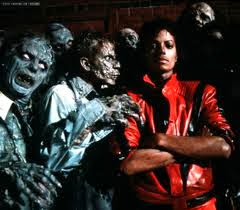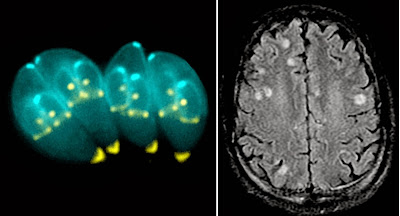Biology concepts – neural parasitology, domoic acid toxicity
Don’t scoff at this; nature is full of examples where one organism can cause another organism to change its behavior – just think of all the silly things boys do trying to impress girls. But first a couple of stories where a change in behavior has less to do with parasitism.
In August 2013, residents of Moscow began reporting that the pigeons were acting odd. They would walk around in a funk, not get out of the way of traffic, and not fly away from danger. One family reported that their dinner one evening was disrupted by a pigeon on their window ledge that lost its balance and fell into their kitchen.
These zombie pigeons (the pecking dead, as one website called them) were freaking out the population, so the scientists went to work. It seems that many of the dead and affected pigeons were carrying salmonella bacteria and/or had Newcastle disease. The virus that causes this disease, unimaginatively called the Newcastle disease virus (NDV), can be transmitted to humans, so it's a good thing the population got freaked out.
The virus causes the birds to stagger about, stumble around in circles, and turn their heads upside down – much like vodka does in humans. However, when humans get NDV, they most likely will just have a flu-like episode.
Zombie birds also led to a famous movie. Alfred Hitchcock’s classic film, The Birds, is the story of a terrifying attack on a small fishing village by many flocks of different birds. They attacked people, flew into car windows and houses, and caused deaths and damage. Seems silly doesn’t it, being killed by a shore bird? I think I would have them give some other reason in my obituary.
The sea lions in 1995 and 2010-11 were acting like zombies as well. They wouldn’t get out of the way of boats or they would come up on land and just keep scooting inland until they died.
In 1987, it was recognized that a toxin produced by certain species of marine algae was responsible for the zombie like behaviors. Called domoic acid, the toxin is produced by the algae and accumulates in marine organisms that feed on phytoplankton or algae that are contaminated. Normally, levels of domoic acid are too low to cause problems, but in years where the algae overgrows, called a bloom, the levels will rise dramatically.
Although the acid seems to have no affect on lower life like shellfish, bigger animals are strongly affected, including humans. When the sea lions or birds feed on contaminated food, they begin to display the bizarre behaviors. In the case of the 1961 birds, there happened to be a collection of samples from the bay that had been kept all these years. Tests on the shellfish and algae samples from 1961 showed high levels of domoic acid.
In a strange coincidence, a new paper has been published about how infections can move through a flock of birds. It uses a mathematical model based on many predictors and factors. The model is called the Zombie-City model, based on how a zombie population might grow in a population of unsuspecting humans. But we want to focus on the loss of free will in nature’s creatures.
Free will in lower animals? It does exist. Most people believe that the behaviors of insects and such are merely responses to environmental and situational cues, and any variation in behavior is due to misreading of cues or random errors. But studies in fruitflies show that they can pick out their own patterns of behavior when a blank canvas is given them.
Ampulex compressa) and the American Cockroach (Periplaneta americana). The wasp lives in Africa and Asia, so this isn’t something we could use to get rid of NYC cockroaches. P. Americana isn’t even native to the Americas. It was introduced from Africa as early as 1625, before it was officially named.
What the wasp steals is the roach’s ability to decide if it wants to walk or run. Most wasps sting to kill, but the Jewel Wasp stings the cockroach in the brain, altering its behavior with its venom. A 2010 study showed that the wasp stings the roach continuously for up to three minutes, trying to locate a particular part of the cockroach’s brain.
What it is searching for is called the subesophageal ganglion, the part of the brain that allows the roach to initiate walking and running movements. When that part of the brain is flooded with venom, the cockroach stands still, with no will to begin leg movements. It isn’t paralyzed – it’s just a zombie.
Another study has started to investigate just how the wasp venom robs the cockroach of its will to walk. There is an insect neurotransmitter called octopamine that is released by some of P. Americana’s neurons. It is this transmitter that allows the cockroach to initiate walking.
The study hasn’t pinpointed just how the venom interrupts the octopamine signaling, but they know if they deplete the amines in the brain, they see the same affect. If they add back octopamine, they can rescue the cockroach’s natural behavior. However, the study also showed that the venom doesn’t reduce octopamine levels and it doesn’t prevent is release, so there's still more work to be done.
Why does the wasp turn the cockroach into a zombie? I’m glad you asked. Remember, the cockroach isn’t paralyzed, it just hasn’t the will to walk on its own. So the wasp tugs on the cockroach’s antennae and herds the roach into its underground nest. There the wasp lays an egg in the cockroach’s abdomen and the emerging larva feeds on the cockroach until they are ready to emerge eight days later.
So why not just kill the cockroach with the sting and lay the egg? The larva need fresh meat, and a dead cockroach rots in one day. To make the meal satisfactory for the eight days needed, the cockroach must remain alive, but in a state where it can’t attack the wasp or the larva; hence the zombification.
It gets even creepier. The wasps have gotten so good at this strategy that they now go to the trouble of cleaning their meal. A 2013 study shows that the wasp larvae produces several antimicrobial chemicals that rid the cockroach of any contaminating bacteria or parasites as the larvae munch on it. I know I’d clean a zombie before I ate it.
There are several other examples of theft of free will, including a couple of fungi that make ants stop their normal work and climb high in trees to allow for the best spread of the fungal spores as they mature. There’s also a hairworm that forces grasshoppers to commit suicide by jumping into water, just so the worm can complete its life cycle. But I don’t want to leave this subject without hitting the king of neural parasitology– Toxoplasma gondii.
T. gondii is a single-celled eukaryotic parasite that has a complex life cycle. It can reproduce asexual in any of the hosts it infects, but can only reproduce sexually in cats, of all things. This is important because sexual reproduction is an obligate life cycle stage for the parasite and contributes to its evolutionary health.
The parasite has taken steps to insure that it finds its way into cats by changing the behaviors of the mice and rats it finds itself inside. It messes with rodent brain chemistry (since it tends to form cyst organisms in the brain) that makes rodents unafraid of cats. In fact, a recent study found that the organism confuses the rodents into believing that cat urine smells like a potential mate!
T. gondiiactivates a certain neuronal transcription factor, which leads to increased production of different proteins in the brain. In rodents and humans, this leads to an increase in dopamine (similar to octopamine in the cockroach) production and a decrease in tryptophan usage.
Because the cysts target areas of the rodent brain that control fear, the change in behaviors are involve, but are not limited to fear. There isn’t any evidence that the cysts have a selective range in the human brain, but considering the changes that occur in men as described below, it is a possibility.
a 2011 study showed that infected men are more attracted to cat urine, while infected women find it less attractive.
In general, men with a long-term T. gondii infection show lower IQs, are taller (about 3 cm on average), and are more likely to break rules, take risks, be jealous, and exhibit anti-social behaviors. Right now – I’m not so proud to be a guy.
On the other hand, women with long-term toxoplasmosis infections tend to be more outgoing, friendlier, more promiscuous, and more attractive to men. Wow, Mars and Venus to the nth degree! The question still remains – how do the forced behavior changes in humans benefit the organism?
Next week, we return to our discussion of nucleic acid exceptions by discussing instances where organisms can rewrite their genetic code.
For more information or classroom activities, see:
Moscow zombie pigeons-
Domoic acid toxicity –
Jewel wasp and cockroach –
Toxoplasma gondii–
Fungal parasites and ants –
Hairworm and grasshopper -
Zombie apocalypse case study for class -





